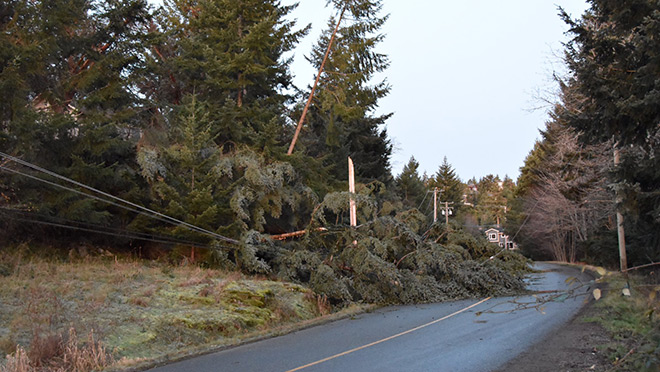La Niña's wet kiss: Are you prepared for a power outage?

Update your emergency supplies, and include a copy of your vaccine card
A well-stocked emergency kit is essential in every B.C. home, and especially in those regions where power outages are more frequent and/or there's a high risk of a major earthquake. But even those of us who feel we're prepared need to be reminded to update supplies (even bottled water has a shelf life) and that items like cash and key documents can prove vital.
Emergency preparation is doubly important this storm season, as a combination of La Nina's arrival and the hot, dry summer could add up to a more severe than usual storm season. In case you missed it, a recent BC Hydro report – The perfect storm – found that the presence of drought-weakened trees puts electrical infrastructure at risk. And BC Hydro meteorologists predicted that La Niña will bring colder, wetter and windier weather to the west coast this fall and winter.
If you don't already have an emergency kit, get details (including a handy checklist, on our Prepare your home for an outage page. And whether you have one or not, consider the following five tips for being prepared.
1. Include cash and key documents
Our reliance on smartphones can get seriously tested in an extended power outage. That's why it's important to include copies of documents such as identification and insurance. And you should add a paper copy of your vaccine card, too, and you can get instructions on how to print one out effectively at gov.bc.ca.
Include cash, in small bills, and keep a copy of your family emergency preparedness plan.
2. Create (and share) an outage plan
Use our step-by-step checklist [PDF, 86 KB] to help you and your family create an outage plan, which can be a part of your overall emergency plan. Use a fill-in-the-blanks document, like this one from gov.bc.ca, and discuss and share it with all household members. It can include where to meet friends/family to stay with if you get separated in an emergency and/or can't return home. Make copies of the plan, and include one in your emergency kit/grab-and-go bag.
3. Replace expired food, water, and prescription medications
It could be years before you need your emergency kit and the supplies in it, or it could be tomorrow. If you have granola bars and other snacks in your grab-and-go back, check expiry dates. Ditto for bottle water, which includes an expiry date because toxins from plastic bottles can leach into the water. Replace any prescription medications that are past their best-before date as well.
4. Build an emergency supplies kit and a grab-and-go bag
Use a plastic bin or two for your full supplies, such as plenty of bottled water, canned food, that can keep you going for between three days and a week. But also put together smaller bags, preferably something like a small backpack that's easy to carry, for both your home and vehicle. See gov.bc.ca for details on what should go in the bigger kit and in the grab-and-go bags.
5. Stay informed, stay safe when the lights go out
While you're discussing your emergency plan, talk to everyone in your home about the basics of staying safe during an outage. See our detailed information about outage reporting and how to stay safe, and don't forget the following:
Check online for outage info, and report it if it's not listed
- If you have a portable generator, never use it (or a barbecue) indoors
- Keep your freezer and fridge doors closed
- Check in on family, friends and neighbours
- Reserve energy in your smartphone by switching to airplane mode, switching off wifi, bluetooth and apps
Related: